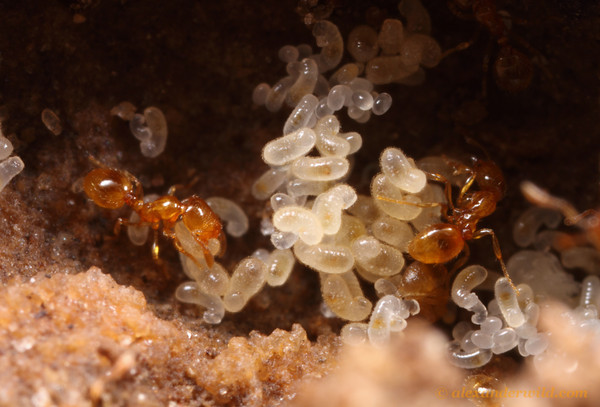Reproduction
The egg of the
thief ant is a small pearl white color
surface, however it changes colors befo re the egg hatches (McColloch
& Hayes, 1916). The Thief ants are small in size and the egg
is about 0.25mm long. Queens usually lay around 105 eggs. When
the queens lay the fertilized eggs, the workers take care for
them. The workers or the queen must attend the eggs in order to
hatch (Hayes, 1920). Workers
regurgitate food such as seeds and place it in front of larvae
to feed them (Hayes, 1920). The
maturation and development of an egg can take anywhere from a
few weeks to a couple months. The incubation period is about 16
to 28 days. Thief ants have four developmental stages before
they become an adult. These include the egg, larva, pupa, and
imago stages (Hayes, 1920). The larval stage is about 21 days, however it varies
based on weather (Hayes, 1920). The
female pupae are bigger than the worker and male pupae (Hayes,
1920).
Most eggs hatch during the summer, however the larvae can live
through the cold winter months (Hayes,
1920). Females usually start mating in June but can mate all the way
through the fall months (Smith M.R.
1965). Virgin females have wings, but lose them when they
become fertile (Hayes, 1920).
re the egg hatches (McColloch
& Hayes, 1916). The Thief ants are small in size and the egg
is about 0.25mm long. Queens usually lay around 105 eggs. When
the queens lay the fertilized eggs, the workers take care for
them. The workers or the queen must attend the eggs in order to
hatch (Hayes, 1920). Workers
regurgitate food such as seeds and place it in front of larvae
to feed them (Hayes, 1920). The
maturation and development of an egg can take anywhere from a
few weeks to a couple months. The incubation period is about 16
to 28 days. Thief ants have four developmental stages before
they become an adult. These include the egg, larva, pupa, and
imago stages (Hayes, 1920). The larval stage is about 21 days, however it varies
based on weather (Hayes, 1920). The
female pupae are bigger than the worker and male pupae (Hayes,
1920).
Most eggs hatch during the summer, however the larvae can live
through the cold winter months (Hayes,
1920). Females usually start mating in June but can mate all the way
through the fall months (Smith M.R.
1965). Virgin females have wings, but lose them when they
become fertile (Hayes, 1920).